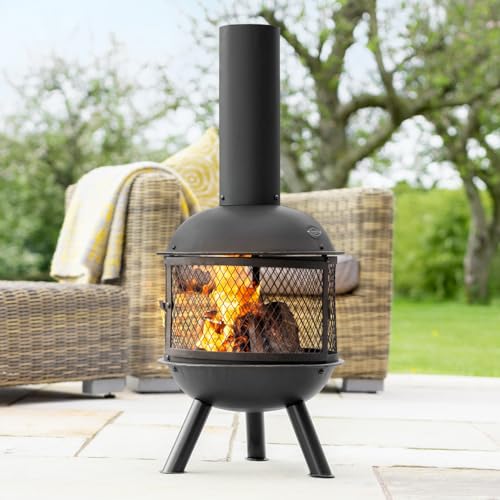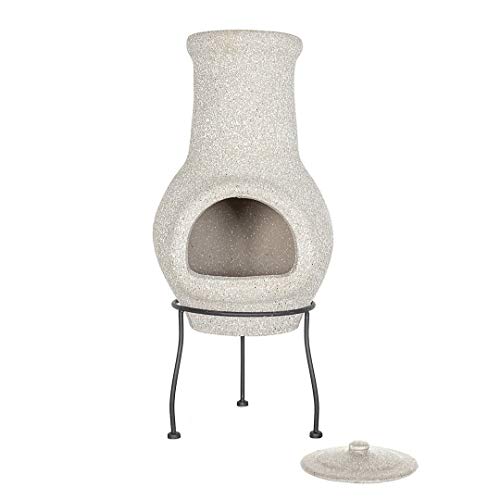9 Things Your Parents Teach You About Chiminea Terracotta
페이지 정보
작성자 Elizabet 작성일24-11-25 15:04 조회4회 댓글0건본문
 A Chiminea Terracotta Adds Warmth and Ambiance to Your Backyard Patio
A Chiminea Terracotta Adds Warmth and Ambiance to Your Backyard PatioA chiminea adds warmth and an atmosphere to your backyard. The chimney is designed to keep the sparks and flames from causing damage to the plants around them and igniting your home or deck.
Chimineas made of clay need to be seasoned (broken in) slowly. The first few flames should be slow and light. The sealing of your chiminea, particularly if you live in a wet climate, is advised.
Material
A chiminea can bring warmth and character to any patio. The pot-belly design of the chiminea is perfect for entertaining. However, innovative designs are now available to fit a variety of decor styles. While clay is the most common material, chimineas are available in cast iron and aluminum. Each type of material has its own advantages. While clay is easy to maintain but Metal chimineas is more robust. It can also be able to withstand higher temperatures.
When selecting a chiminea, take into consideration its size, style and fuel type. The size of the chiminea should be able to be able to accommodate the amount of wood you'll be using to keep it burning at a steady flame. The larger chimneys are suitable for large gatherings while smaller models work best in smaller spaces. A chimney is a vent that directs smoke upwards to shield the area from rain and preventing it from being blown around by strong winds.
The design of a chiminea distinguishes it from other outdoor fire pits. The bowl-shaped base shields the flames from wind, rain, and debris. The chimney is attractive and allows you to regulate the size of the flames.
Chimineas of clay are formed and molded by hand then glazed at high temperatures. They are usually coated with a ceramic glaze in order to make them more attractive and durable against weather damage. Some are decorated with Mexican-inspired motifs. These chimineas can be purchased in garden stores and home improvement centers.
Before lighting a chiminea, it is recommended that you must cover its interior with coarse-grained gravel or sand. Sand helps to reduce smoke and also prevents the clay from cracking during firing. After you've covered your base, put a few pieces of kindling in the center. Include a fire lighter made from natural like this one from Amazon to make it easier to light.
When you are ready to cook Use a long-handled fork or spatula to turn the hot embers. Cooking food should not be done directly on active flames as it can burn and darken the food beyond recognition. Instead, start with the smokey embers and gradually build up a large fire. Then, transfer the cooking pan to the top of the smoke stack.
Design
Chimineas look like a potbelly stove, with a wide base and a long thin chimney to collect the smoke. The chimney also protects the fire from rain and wind and can also extinguish a more open fire pit. Chimineas were used for more than four hundred years to gather cooking, heating homes and gatherings. The clay used to make them was originally a hand-made product, but they're now available in cast iron or terracotta, with modern and traditional styles.
While modern chimineas often eschew the curvatures of older models, they retain a distinctive chimney design. They are available in a variety of shapes and sizes, from 12 to 16 inches at the base and from 25 to 30 inches in height (including the stand). The chimney usually rises about 6 feet.
The size of a chiminea's height is crucial because it helps direct smoke upward, which can keep it from blowing on people and things in your home or yard. It is also possible to use aromatic woods, which smell great as they burn. This can enhance the experience.
When choosing a chiminea to buy, choose one made of durable materials that can withstand extreme heat. Beware of models that have decorative elements or other features that could crack or break under heat. If you decide to purchase a clay chiminea or terracotta one, it is essential to season it by burning small amounts wood for 3 to 4 times. This will allow the clay to cure. When not in use the chiminea should be covered with a lid to prevent water from spilling onto the flames. This can cause it burn.
Cast iron chimineas can stand up to higher temperatures and rougher treatment because they are heavier and more durable than clay models. They also offer more versatility, as they can burn briquettes or coal in addition to wood. However, if you're going for a classic style choose an aluminized chiminea.
Whatever material you choose, make sure to place your chiminea in a fire-safe space away from your home and outdoor furniture or plants. The chiminea should also be placed at least 10 feet from any other structure such as fencing or sheds. Create a hearth for your patio with pavers to create an area to put your chiminea, making it easier to manage the flame.
Installation
A chiminea is the focal point of any gathering of the family and adds an additional dimension to outdoor spaces. It is essential to understand the maintenance requirements of a chiminea before purchasing one. Traditional clay chimineas tend to be more fragile than cast iron chimineas, although both can withstand the elements, but the differences in design and materials require a different approach to maintaining.
The first thing to do is to prepare the base of the chiminea. The bottom should be covered with sand, gravel or lava rock to keep it out of direct contact with the fire. This will help reduce smoke and also prevent the chiminea from cracking.
It is crucial to make sure that the tall chiminea has been placed in a safe and secure location. Never put it on a deck or any other flammable surface. If you must place it in a place that is flammable then use a metal grate to elevate the wood. This will protect the chiminea from fire's heat and sparks. fire.
It is essential to spruce up the chiminea prior lighting it for the first time. This can be done by lighting a few small fires. This will prevent it from cracking if you burn a lot of wood.
After every fire pits and chimineas Clean the chiminea thoroughly by rubbing it with a wire-bristle brush or cloth. You should remove any ash or creosote from the inside of the chiminea, too. These chemicals will impact the quality and amount of fires you could be able to have in your chiminea, if they are not removed.
The chiminea must be sealed with a protective cover whenever it is not being used. This will prevent the clay from getting too wet and shrinking or cracking. If exposed to snow or rain, chimineas can suffer from this kind of damage.
Even in the summer, it is best chiminea to cover the chiminea. It is also a great idea to have an alternative fuel source for the fire such as wood or propane tanks. In addition, it is a good idea to keep an extinguisher in the vicinity to eliminate any sudden flames.
Maintenance
Despite the varying materials that chimineas are fabricated from, they all require regular maintenance to ensure they last as long as possible. This means keeping the structure clean, applying protective coatings, and properly storing it during off-season periods to guard against extreme weather conditions. These steps and the basic guidelines for use can prolong the life of your Chiminea, and also reduce the risk of injury.
Chimineas, which is composed of clay, may break if exposed to extreme temperature changes. It is important to store your terra-cotta in an area that is dry and secure during the off season. A cover will keep it safe from rain and frost. It's also a good idea to regularly apply a sealant that is protective on your clay chiminea to protect it from changes in temperature and moisture.
To avoid damaging the clay surface make use of a non-abrasive material and a soft cloth or brush to clean a chiminea. A hose or bucket of water is the best way to wash off the surface after scrubbing, and it's essential to let the chiminea dry completely before using it again. This will stop mildew and mold growth and keep it looking new.
If your chiminea has a cracked or damaged section, it is essential to clamp the broken pieces together and then apply outdoor oven cement to the crack. You can buy this at the majority of hardware stores. It needs to be applied with a spatula or pointing trowel. The cement needs to be allowed to dry completely before lighting a test fire inside the chiminea.
 After the cement has dried, use medium-coarse sandpaper on the damaged area to prepare it for painting. Then you can paint it with a paint that is masonry or household in a color that matches your largest chiminea. If there is any rust or corrosion you can get rid of it by sanding and then cleaning the affected areas with water.
After the cement has dried, use medium-coarse sandpaper on the damaged area to prepare it for painting. Then you can paint it with a paint that is masonry or household in a color that matches your largest chiminea. If there is any rust or corrosion you can get rid of it by sanding and then cleaning the affected areas with water.댓글목록
등록된 댓글이 없습니다.